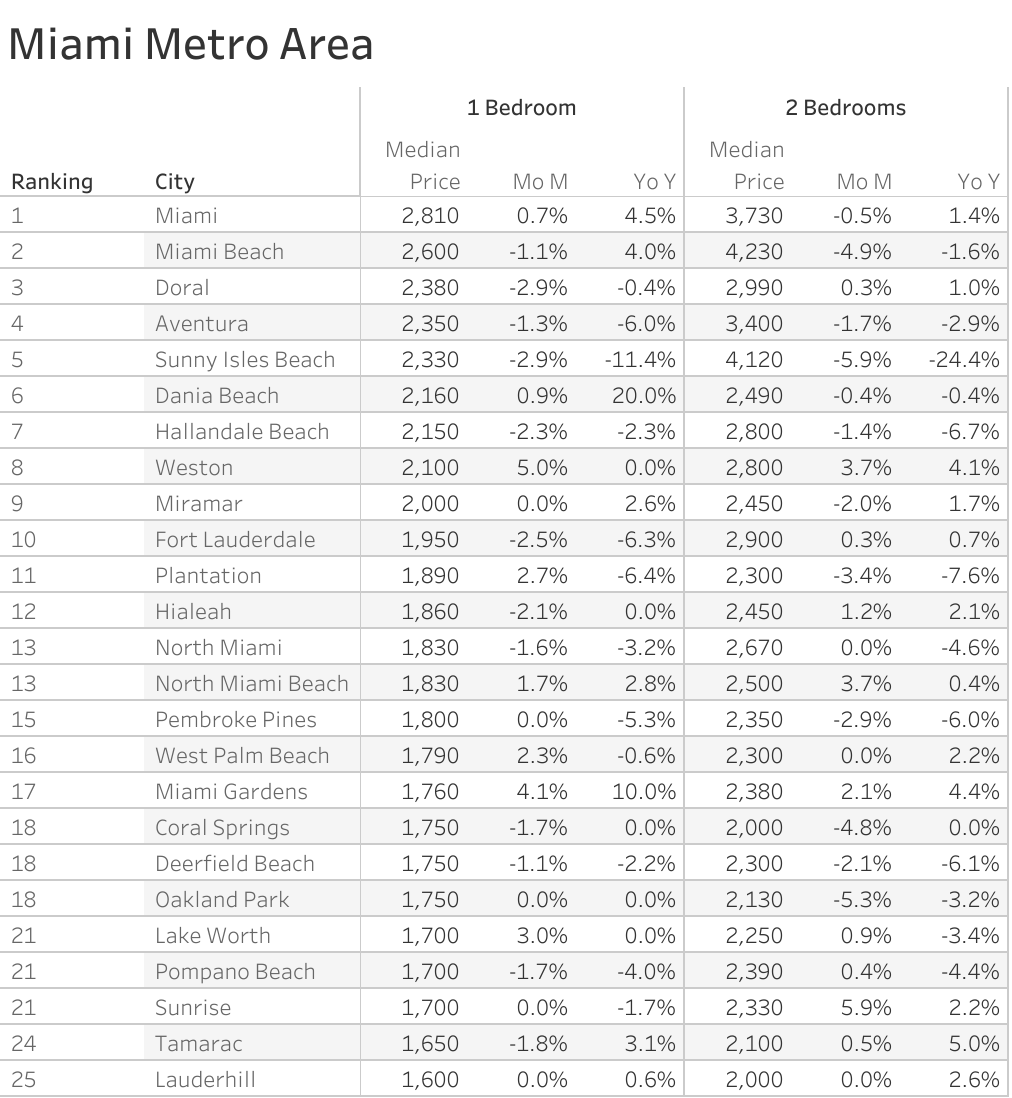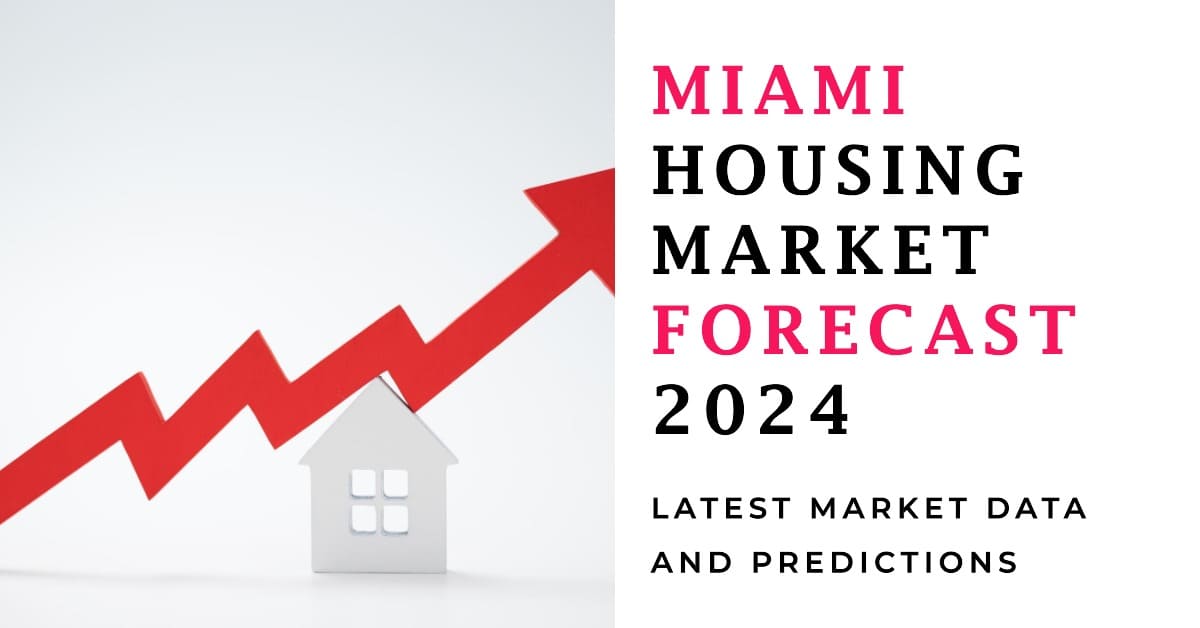South Florida housing market is strong. In particular, the Miami housing market has shown remarkable growth in both single-family home and condominium sales, particularly in the luxury segment, despite recent economic fluctuations. As of August 2024, there has been an increase in single-family home sales, marking notable year-over-year gains, while luxury condominiums priced at $1 million and up have surged significantly. This post will explore various dimensions of the Miami housing market, including sales statistics, pricing trends, and the overall market outlook.
Table of Contents
Miami Housing Market Trends 2024
Key Takeaways
- Single-family home sales in Miami-Dade County increased by 1.7% year-over-year.
- The median sale price of single-family homes rose by 3.2%, reaching $640,000 in August 2024.
- $1M+ condominium sales soared by 122.2% compared to pre-pandemic levels.
- Miami continues to lead in home price appreciation nationally.
- The inventory of homes remains below historical averages, indicating a seller’s market.
The Growth of Home Sales
In the last few years, Miami's single-family home sales have exhibited substantial growth, reflecting the area's desirability. In August 2024, Miami single-family sales saw a year-over-year increase of 1.7%, moving from 948 to 964 transactions. Notably, the market has experienced gains in eight of the last ten months, demonstrating a consistent upward trend in the sales volume. This growth is attributed largely to the high demand driven by both local and out-of-state buyers.
Condominium sales, particularly those in the luxury bracket ($1 million and up), have reported exceptional growth as well. There was a 122.2% increase in these luxury condo transactions compared to pre-pandemic figures, indicating a robust recovery and significant interest in high-end properties. Such a dramatic surge can be linked to several key factors, including the overall recovery of the economy and the ongoing influx of affluent buyers into the Miami area.
Home Prices on the Rise
Home prices in Miami have shown a consistent upward trajectory. The median sale price for single-family homes rose 3.2% year-over-year, climbing from $620,000 to $640,000 as of August 2024. Impressively, Miami single-family home prices have increased 156% between August 2014 and August 2024, highlighting a long-term trend of appreciation.
In the condominium sector, the price of a median condo has also risen dramatically, achieving a 128% increase over the past decade, from $182,000 in August 2014 to $415,000 in August 2024. While there was a slight decrease in the median prices of existing condos (down 0.2%) from last year, the stability and gradual increases seen over the years provide a positive outlook for potential investors.
Miami's home price ranking continues to stand out nationally, as the city ranks first in the U.S. in terms of home price appreciation as of September 2024. A typical single-family home purchased in Miami around 2009 and sold in early 2024 saw equity gains of approximately $533,955, which is significantly higher than the national average of $287,111.
Housing Supply and Demand Challenges
The lack of housing inventory has become a persistent challenge in Miami, particularly with lower supply levels compared to historical averages. As of August 2024, total inventory stood at 14,277 active listings, which is 42.2% below the historical average for Miami. While inventory did see a notable 50.8% increase year-over-year, the total active listings still fall short of substantial demand.
The months’ supply of inventory reveals a seller’s market situation for both single-family homes (approximately 4.7 months) and condominiums (approximately 9.5 months). A balanced market typically sees about six to nine months supply, further emphasizing the tightness and resulting competitive environment for homebuyers.
Significantly, Florida's Live Local Act encourages developers to focus on building more affordable housing, which could alleviate some supply constraints in the long run. This Act allows developers to maximize density if at least 40% of their units are designated for affordable housing, which is defined as being at or below 120% of the area’s median income.
Market Trends Going Forward
The outlook for Miami’s housing market in the coming years appears positive. The recent Federal Reserve rate cuts and the reduction of mortgage rates to 6% as of September 2024 could stimulate further buying activity, especially among those currently waiting on the sidelines. Predictions suggest mortgage rates might decline to as low as 5% by the end of 2025, fostering an environment ripe for investment in real estate.
Moreover, a report from MIAMI REALTORS® suggests that the economic impact of home sales is significant, with each typical sale generating approximately $123,000 in economic activity. This reflects the essential role that the housing market plays in the broader Miami economy, from construction to household goods and services.
My Opinion on Miami’s Housing Market Trends
As an expert in the real estate sector, I see the Miami housing market as a thriving investment venue. The consistent rise in home prices, strong demand, and economy supported by migration trends bolster my confidence that this market will remain resilient, even as challenges like inventory shortages persist.
Miami Housing Market Forecast for 2024 and 2025
According to latest analysis, the anticipated trend for Miami's home prices shows a slight decrease of 0.1% by September 2024, followed by more stable growth of 2.5% by August 2025 (Zillow). This forecast indicates a gradual recovery in the market dynamics
Miami Housing Market Forecast
Overall Outlook: Positive Growth
| Date | Forecast |
|---|---|
| Sep 2024 | -0.1% |
| Nov 2024 | -0.5% |
| Aug 2025 | +2.5% |
Overall Trend: Upward Shift
Should You Invest in the Miami Real Estate Market?
Population Growth and Trends
When considering investment in the Miami real estate market, population growth and trends play a pivotal role. Miami's population has been steadily growing over the years, driven by both domestic and international migration. Here's why this matters for investors:
- Population Growth: Miami's population has been on an upward trajectory, attracting residents from all over the United States and abroad. This influx of people creates a consistent demand for housing, making it an attractive market for real estate investors.
- International Appeal: Miami's international appeal is a significant driver of population growth. The city's vibrant culture, pleasant climate, and international business connections make it a magnet for individuals from around the world. For investors, this diverse population presents opportunities in various real estate sectors, including residential and commercial properties.
Economy and Jobs
Examining the economy and job market is critical for real estate investment decisions:
- Economic Strength: Miami boasts a diverse and robust economy. It's a hub for international trade, tourism, finance, and technology. A strong and diversified economy helps ensure a stable demand for real estate, both for commercial and residential purposes.
- Job Opportunities: The availability of job opportunities in Miami is a key factor for real estate investors. A thriving job market attracts professionals, and this, in turn, leads to higher demand for rental properties, as many newcomers prefer renting initially.
Strong International Market
Miami's real estate market benefits from a strong international presence:
- Global Investment: Miami is a favored destination for international investors. Buyers from South America, Europe, and other regions consider Miami a safe and attractive place to invest in real estate. As an investor, you can tap into this global demand for properties.
- Foreign Investment: Foreign investors often seek properties in Miami for various purposes, including vacation homes, second residences, and income-generating rental properties. This international interest adds stability and growth potential to the local market.
Livability and Other Factors
Livability and lifestyle factors contribute to the city's attractiveness:
- Lifestyle Appeal: Miami's lifestyle, with its beautiful beaches, cultural attractions, and vibrant nightlife, makes it an appealing place to live. This lifestyle appeal increases demand for both residential properties and rental units.
- Weather and Climate: Miami's tropical climate is a major draw for residents and tourists alike. The city's pleasant weather encourages year-round tourism and can contribute to the demand for rental properties.
Big Rental Property Market Size and Its Growth for Investors
Miami offers a thriving rental market:
- Rental Demand: The city's diverse population, strong job market, and international appeal create a substantial demand for rental properties. This is advantageous for real estate investors, as it means a steady stream of potential tenants.
- Rental Income Potential: Miami's rental market has significant income potential. Depending on the neighborhood and property type, investors can generate attractive rental income. High rental rates can translate into favorable cash flow for property owners.
The Zumper Miami Metro Area Report analyzed active listings last month across the metro cities to show the most and least expensive cities and cities with the fastest-growing rents. The Florida one bedroom median rent was $1,623 last month. Miami was the most expensive city with one-bedrooms priced at $2,810. Lauderhill ranked as the least expensive city with rent at $1,600.
Here are the top cities in the metro area where rents are increasing. You can think of investing in these places because they have strong growth and demand for rental properties. You can also use their historical annual growth in rents to help predict future increases or decreases.
The Fastest Growing Cities in Miami Metro Area For Rents (Y/Y%)
- Dania Beach had the fastest growing rent, up 20% since this time last year.
- Miami Gardens saw rent climb 10%, making it the second fastest growing.
- Miami was third with rent increasing 4.5%.
The Fastest Growing Cities in Miami Metro Area For Rents (M/M%)
- Weston had the largest monthly growth rate, up 5%.
- Miami Gardens was second with rent climbing 4.1%.
- Lake Worth ranked as third with rent increasing 3% last month.

Other Factors Related to Real Estate Investing
When contemplating investment in the Miami real estate market, it's essential to consider these additional factors:
- Market Trends: Staying informed about market trends, such as price appreciation, rental rates, and property supply, is crucial. These trends can influence your investment strategy.
- Local Regulations: Understanding local real estate regulations, property taxes, and zoning laws is vital for investors to navigate the market effectively.
- Property Management: Whether you plan to manage properties yourself or hire a management company, efficient property management is key to successful real estate investments.
- Diversification: Consider diversifying your real estate portfolio in Miami by exploring different property types, from single-family homes to commercial properties.
Highest Appreciating Miami Neighborhoods
When considering real estate investments, it's crucial to evaluate the historical performance of neighborhoods. The following Miami neighborhoods have demonstrated significant appreciation since 2000, making them noteworthy areas for potential investors:
Downtown North
- **Appreciation**: Downtown North has experienced substantial appreciation in real estate values over the past two decades. This makes it an attractive prospect for investors seeking long-term growth.
- **Location**: Situated in the heart of Miami's downtown area, Downtown North offers proximity to key amenities, cultural attractions, and business centers.
- **Potential**: With its central location and upward trend in property values, Downtown North presents opportunities for investors interested in urban real estate.
Little Haiti South
- **Appreciation**: Little Haiti South has seen remarkable appreciation since 2000. This neighborhood's transformation has been driven by its cultural vibrancy and proximity to downtown Miami.
- **Cultural Hub**: Little Haiti South has become a cultural hub, attracting artists, creatives, and entrepreneurs. This cultural renaissance has boosted its real estate market.
- **Investment Appeal**: Investors seeking neighborhoods with both historical significance and growth potential should consider Little Haiti South.
Overtown North
- **Appreciation**: Overtown North's appreciation over the years highlights its potential for real estate investment. This historic neighborhood has witnessed resurgence.
- **Revitalization**: Overtown North has been a focus of revitalization efforts, leading to improved property values and a growing sense of community.
- **Investor Opportunities**: For those interested in contributing to the revitalization of a historic neighborhood while realizing financial gains, Overtown North is a compelling choice.
Overtown West
- **Appreciation**: Overtown West has undergone a transformation, with appreciating real estate values. This neighborhood showcases the potential for investors in areas undergoing positive change.
- **Community Development**: Overtown West's development initiatives have contributed to its growth. Investors can participate in community development projects while benefiting from rising property values.
- **Future Prospects**: Overtown West is a neighborhood to watch for those interested in urban redevelopment and investment in emerging areas.
Downtown Southeast
- **Appreciation**: Downtown Southeast's real estate market has shown consistent appreciation over the years. Its location and urban development make it an appealing choice for investors.
- **Urban Development**: Downtown Southeast has witnessed significant urban development, including new residential and commercial projects. This development has boosted property values.
- **Investment Potential**: With its ongoing urban transformation, Downtown Southeast presents promising investment opportunities for those looking to capitalize on urban growth.
Downtown Northwest
- **Appreciation**: Downtown Northwest has experienced notable appreciation in real estate values since 2000. Its proximity to downtown Miami and growth in infrastructure contribute to its appeal.
- **Proximity to Downtown**: The neighborhood's location near downtown Miami is a key factor driving appreciation. Residents enjoy easy access to the city's business and entertainment districts.
- **Investor Advantages**: Downtown Northwest offers advantages for investors seeking a strategic location and potential for long-term appreciation.
Downtown
- **Appreciation**: The central Downtown area of Miami has consistently appreciated in real estate values. Its status as the city's core business and cultural district contributes to this growth.
- **Economic Hub**: Downtown Miami is an economic hub, home to numerous businesses, cultural institutions, and entertainment venues. This dynamic environment supports property value growth.
- **Investment Opportunities**: Investors looking for real estate in the heart of the city should consider Downtown Miami, given its appreciation potential and urban vibrancy.
Downtown East
- **Appreciation**: Downtown East has seen substantial appreciation, benefiting from its location within Miami's thriving downtown district.
- **Urban Growth**: Downtown East has experienced growth in both residential and commercial developments. This urban expansion has contributed to property value appreciation.
- **Investment Appeal**: Investors interested in neighborhoods within the urban core of Miami should explore Downtown East's potential for investment and growth.
Town Square
- **Appreciation**: Town Square's appreciation since 2000 makes it a noteworthy area for real estate investors seeking long-term gains.
- **Location**: The neighborhood's location offers accessibility to key amenities and is situated in a dynamic urban environment that supports property value growth.
- **Investment Prospects**: Town Square provides investment prospects in a vibrant urban setting, making it a compelling choice for real estate investors.
Park West
- **Appreciation**: Park West has demonstrated significant appreciation over the years, positioning it as an attractive area for investors.
- **Urban Development**: Park West has witnessed urban development, including entertainment venues and commercial establishments. This development has enhanced property values.
- **Investor Opportunities**: Park West offers investment opportunities in a growing urban district with the potential for long-term appreciation.





